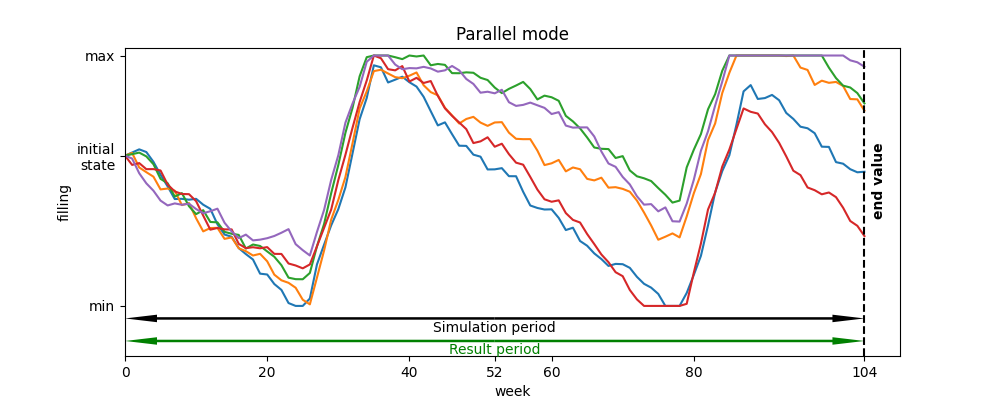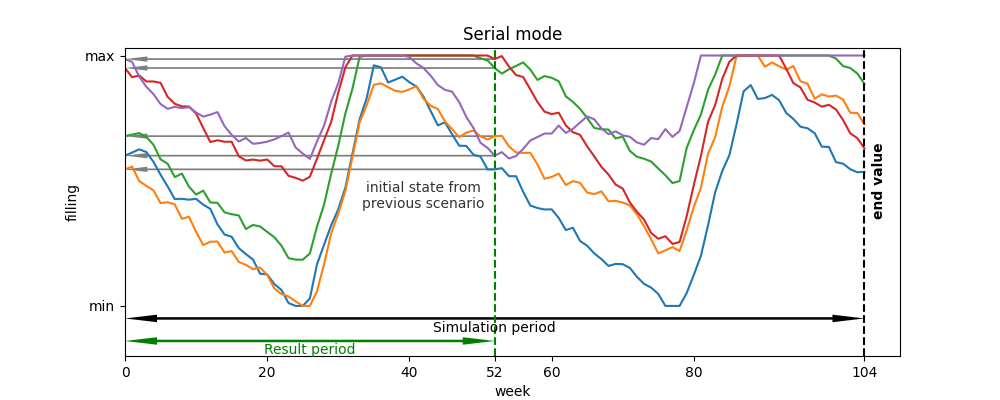Serial mode#
Prodrisk has two different modes of operation:
parallel mode: used for operational water value calculation
serial mode: used to analyze a longer time period, e.g., for an investment analysis
The mode of operation is controlled by the setting attribute is_series_simulation in the API. If the attribute is set to True, Prodrisk will run in serial mode. When running Prodrisk from the command line, the mode of operation is chosen within the interactive dialogue at the beginning of the program.
In serial mode, the simulated scenarios are interpreted as consecutive years. Thus, the reservoir level after 52 weeks in scenario 1 becomes the initial reservoir level in scenario 2, and so on. The coupling of scenarios is cyclic, i.e., scenario 1 receives its initial state from the last scenario. In consequence, all scenarios start at different states which are determined self-consistently by the optimization algorithm. The user input on the initial filling is thus overwritten. Because of the scenario coupling, serial simulations often need more iterations to reach convergence than a parallel simulation for the same river.
If serial simulation is chosen, results are reported for 52 weeks per scenario. It is recommended to run Prodrisk with a longer horizon, though. Otherwise, the end-value setting will interfere with the scenario coupling at week 52 and lead to meaningless reservoir trajectories.
The reservoir levels from a parallel and a serial simulation are schematically illustrated in the figures below for 5 scenarios (representing a 5-year period in serial mode) with a horizon of 2 years.


Input scenarios for a serial simulation#
To run a serieal simulation for n years with a suitable horizon in Prodrisk, e.g., three years, the input scenarios must be prepared based on the same cyclic scenario coupling that is assumed by the algorithm. Namely, the first scenario must consist of data for years 1, 2, and 3. The second scenario must consist of years 2,3, and 4, etc. The second-last scenario consists of years n-1, n, and 1. The last scenario consists of years n, 1, and 2. In contrast, the scenarios for a parallel simulation can be independent over the entire horizon.
If Prodrisk has enough time left in the calculation after week 52, the results from the serial simulation will become nearly independent of the end-value setting. How long Prodrisk’s horizon should be depends on the watercourse. It is recommended to set the horizon in years larger than the regulation level of the largest reservoir. For instance, if the largest reservoir could store inflow from up to two years, then a serial simulation for that watercourse should be run with at least two years horizon.
Implementation as pseudo-series simulation#
To save calculation time, Prodrisk computes all scenarios in parallel, even in serial mode. The scenario coupling is implemented by setting the initial state per scenario based on the corresponding final state in the previous iteration. This is an approximate scheme where convergence is not strictly guaranteed. In consequence, it is possible that discontinuities occur in reservoir levels in the transition between years. In addition, the final forward simulation in Prodrisk may use slightly different (more physical) assumptions than the previous iterations, which can cause leaps even if the previous iterations had converged. Such leaps are in most cases insignificant, but it is recommended to check the continuity of results. The figure above illustrates a fully converged case without any leaps.
